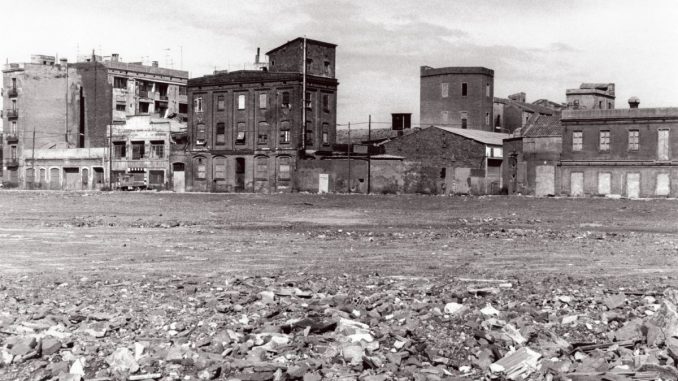
The Vila Olímpica is the biggest planned intervention of Barcelona in the 20th century. It was conceived as the New Icaria of the post-industrial city, and was built to trigger the regeneration of the waterfront of Poblenou, an area historically devoted to rundown and unhealthy productive activities. Its construction required the demolition of the old buildings and the eviction of its residents, as in the hygienist urban planning of the 19th century. The utopia of a neighborhood without conflicts, built for civic and peaceful citizen that will embody the image of the ‘Barcelona model’, is justified through a politics of memory that pretends to be universal, but that requires the institutionalization of forgetting.
However, some exiled memories survived the destruction, and come back to life whenever one of the evicted returns on the spot. I walked through the Vila Olímpica with one of its former residents and witness how history slowly unfolded in his narrative. The working-class neighborhood he described was fully part of Poblenou, though it withheld a character of frontier towards Barcelona; he didn’t know the name ‘Nova Icària’ with which its documents are now stored in the archives, but he felt it as a place that retains memories of his childhood. He affirms the existance of a neighborhood identity that was broken after relocation to the new blocks between carrer Bilbao and Gran Vía. While we walked, he evoked memories of a daily life he spent in the streets, in a landscape that was together rural and industrial. This imaginary that I captured in his words temporary unsettled the univocal legibility of the Vila Olímpica as it is represented in official history; without any doubts, any body that crosses the space brings a symbolic transformation in the built environment.
- Gabriela Navas Perrone (2016) “La vocación utópica del urbanismo: El caso de la Vila Olímpica de Barcelona”, Coloquio Internacional Geocrítica [PDF]
- Gabriela Navas Perrone (2016) “Passejant per la Vila Olímpica: El tancament de la vida enfront de l’amenaça d’incivisme”, Diagonal 13 octubre [enlace]
- Stefano Portelli (2004) “Il grattacielo seppellì gli idealisti”, Il Manifesto, June 12th [PDF in italian][link]
- Francesc Caballé (2010) “Desaparece el barrio de Icària, nace la Vila Olímpica”. Biblio3W [link]
- Solà Morales et al. (1974) Barcelona: Remodelación capitalista o desarrollo urbano en el sector de la Ribera Oriental. Gustavo Gili [on SCRIBD]
- The documents that are kept in the Centre de Documentació del Servei d`Arqueologia de l’Institut de Cultura, that include the 6-volume Estudi històrico-arquitectònic del sector Avinguda Icària – Passeig Carles I, are an insight into the industrial landscape that occupied the area in which the Vila Olímpica was built, an emblematic project of the ‘Barcelona model’, justified through the use of 1992’s Olympic Games. The work was promoted by the Servei d’Activitats Arqueológiques, that appointed the Servei de Protecció del Patrimoni Monumental de l’Ajuntament de Barcelona the task of cataloguing the industrial heritage, with funds of VOSA itself (Vila Olímpica, S.A.). The Estudi Històrico-Arquitectònic del sector Avinguda Icària-Passeig Carles I, was elaborated by Manuel Arranz, Reinald González, Teresa Navas, Marta Puchal y Francesc Caballé, and completed with a report on daily life of its residents by anthropologist Concha Doncel.
- “We have always been a frontier“, a 2014 post about the Vila Olímpica in Perifèries urbanes.